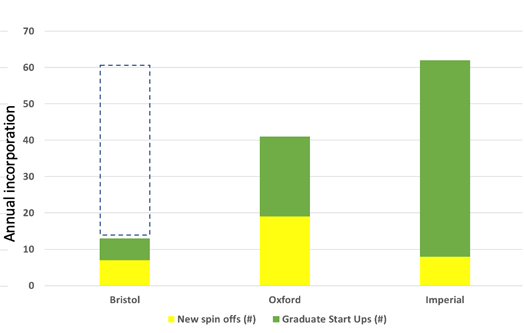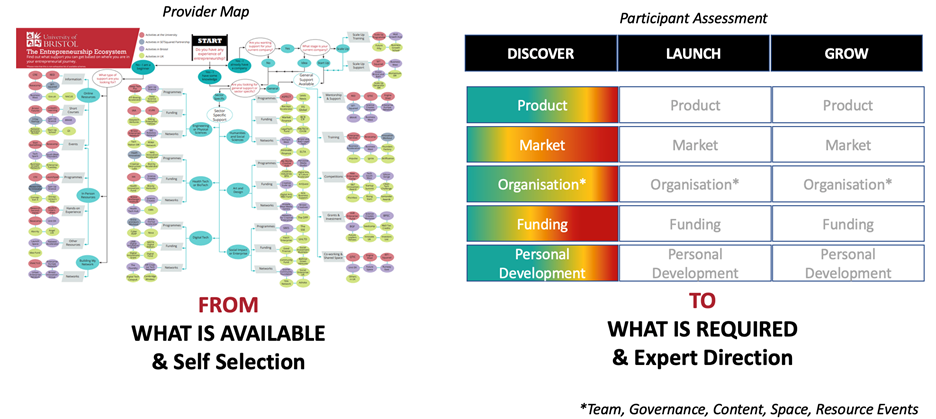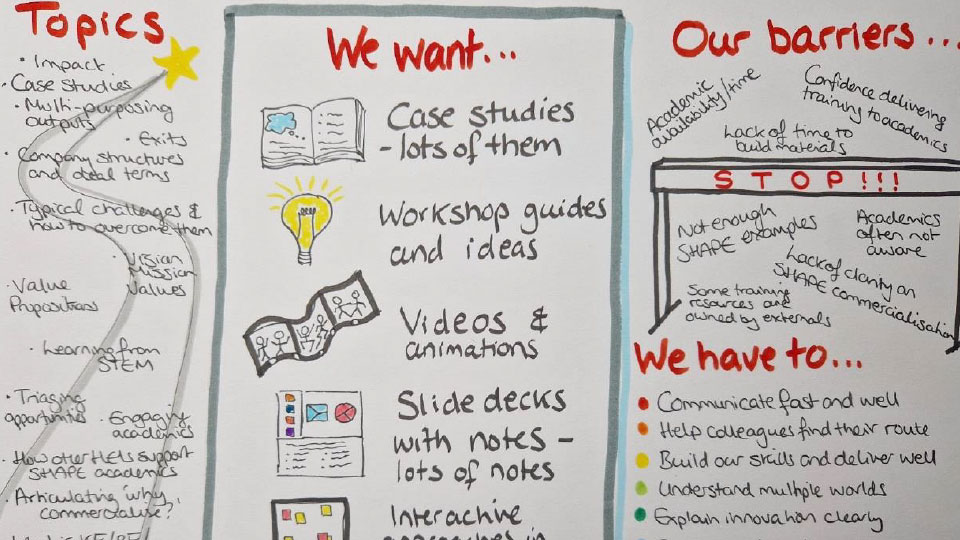Conceptualising a user-centric pathway for entrepreneurial support
Based on user research and stakeholder engagement across the university and in the local community, Bristol’s Research and Enterprise Development (RED) team conceptualised a new pathway for accessing entrepreneurial support at the university. The concept is notable for coordinating all existing entrepreneurship support under one pathway—that is support to academics, staff and students—and creating a data-centric reporting system.
We share learnings from the team’s conceptualisation journey. We anticipate that this is informative for university entrepreneurship hubs exploring ways to streamline access to support.
1. Creating a clear and measurable goal
In order to set the context and identify potential performance metrics to adopt, the team started by benchmarking entrepreneurship statistics at Bristol against those of leading performers in the UK, including U. Oxford and Imperial College London.
The exercise showed a substantial difference in the number of start-ups founded by students or graduates from Bristol as compared to Oxford or Imperial, indicated in Figure 1. Based on this finding, the Bristol team zeroed in on the key goal of “increasing the volumes of participants and founders” at Bristol. The goal is clear and measurable, providing a concrete north star for which progress can be assessed.
In addition, the explicitly defined goal mitigated against the challenge of, what the Bristol team saw as, a multiplicity of goals expressed in varying clarity by different internal stakeholders across the university’s entrepreneurship ecosystem. The goal provides a common reference point to move forward.

2. Developing a framework for understanding users
The Centre for Innovation and Entrepreneurship (CFIE) at Bristol conducted research to identify the range of user types or personas that may access entrepreneurship support at the university. The RED team adopted the framework developed from this research, which oriented a total of 19 user personas along a two-dimensional plane, based on extent of being “innovation-ready” and “entrepreneur-ready” (see Figure 2). Here, “innovation-ready” refers to maturity of domain knowledge or idea, while “entrepreneur-ready” refers to entrepreneurial acumen, such as understanding what it means to start a business and readiness to take it on.

This framework is useful for understanding the spread of different user types and for forming the basis for the guiding the high-level user journey. Broadly speaking, academics fall in the top-left quadrant of Figure 2, that is high in “innovation ready,” but low in “entrepreneur ready,” while most students would fall in the bottom-left quadrant, that is low in both respects. The goal of the pathway would be to guide those starting in top-left, bottom-left, or bottom-right quadrants towards becoming a suitable persona in the top-right quadrant (high in both “innovation ready” and “entrepreneur ready”).
Aspect member, U. Manchester, agreed that having a framework is important even as a mental guide for visualising each user type and what types of support they need to get to where they want to be.
3. Assessing participants and providing feedback at each developmental stage
Further evaluation of the existing pathway of support led to a few key findings:
- Limited and inconsistent resources into the pre-incubation stage
- Lack of continuity of support and signposting
- Inconsistent tracking
- Limited pipeline from innovation through to incubators
- Two parallel journeys of knowledge innovation and commercial development
The RED team conceptualised a new pathway based on participant assessment replacing an existing provider map approach in order to provide “a more consistent, high quality and structured way to direct users to the right support” (see Figure 3).
This pathway will involve assessing users along five areas—product, market, organisation, funding and personal development—depending on their developmental stage: discover, launch and grow. The assessment will identify strengths and weaknesses relative to a user’s stage and allow the pathway to point users towards relevant support and resources according to areas for improvement. This approach aims to provide users with timely feedback on what they need at each stage and endeavours to tighten the feedback loop so that participants may learn faster, which may include failing and/or realizing that entrepreneurship is not the right career path for them.

4. Towards a new and scalable pathway
Finally, the RED team diagrammed the user journey for the new user-centric entrepreneurship support pathway, which provides a visually compelling presentation of the concept (see Figure 4). The team noted the value of the diagram in clarifying the concept for many stakeholders.
In order to make this model scalable, Bristol will also migrate to a completely software-based system in tracking this user journey on a centralised reporting system. The team’s five-year plan includes seeing the total number of applications grow by 10x from 100 to 1,000 applications and total exits increase from 0 to 5.

Recommendations
Over the course of several months, the RED team at Bristol successfully conceptualised a new user-centric pathway and guided eco system for entrepreneurial support that will begin implementation starting in July 2021. The team has also shared an account of challenges faced during the conceptualisation process and offer learnings on mitigating these challenges.
- Everyone needs to gain
Bristol identified two related key challenges as being obtaining senior management buy-in and effectively communicating challenges and gaps to internal stakeholders. Stakeholders could be disinterested. Therefore, it was important to be able to demonstrate desirable gains and advantages for all stakeholders (i.e. including participants) and the institution as a whole.
For example, the opportunity to generate clear propositions and marketing material from the data generated through a centralised reporting system that would result from the new ecosystem concept proved to be persuasive. Aspect member, LSE, noted that it is invaluable to access insights on specific goals and metrics that are important to senior management at particular points in time and aligning communications accordingly. - It is possible to innovate within the existing structure
The Bristol team noted the impracticality of any attempt to completely overhaul a system in the university setting. Therefore, it was more pragmatic to navigate the conceptualisation process with a goal of providing a user-centric approachwhile working with the existing set of programmes and service providers at the university. The new guided supported ecosystem aims to drive greater impact for each programme by building on and connecting them.
Conclusion
Through carrying out user research and months of stakeholder engagement across the university, Bristol’s Research and Enterprise Development (RED) team conceptualised a support system for accessing entrepreneurial support at the university, which will begin implementation in the coming months. The team’s conceptualisation journey may prove informative for university entrepreneurship hubs that are also exploring ways to consolidate and streamline the pathway for accessing university entrepreneurship support.
Photo credit: Achim Bongard via Pexels




